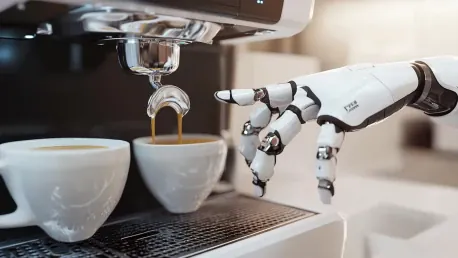The groundbreaking advancements in AI and robotics are beautifully illustrated by a new coffee-making robot. Developed by researchers from the University of Edinburgh and their collaborators, this innovative machine signifies a substantial leap in robotic capabilities. Unlike traditional robots that operate in controlled, predictable environments, this AI-powered coffee robot navigates the dynamic and unpredictable nature of a bustling kitchen.
Integration of Advanced AI and Motor Skills
Addressing the Limitations of Traditional Robots
Traditional robots have long struggled to perform effectively outside of highly controlled environments. Factories, where tasks are repetitive and predictable, have always been a natural fit for these machines. However, when it comes to navigating environments with a higher degree of variability, such as homes or kitchens, traditional robots tend to falter. The primary challenge faced by these robots is their reliance on pre-programmed actions and responses, which significantly hampers their ability to adapt to unforeseen obstacles and real-time changes. The coffee-making robot addresses this issue by demonstrating an advanced model that integrates complex motor skills with sophisticated AI to operate efficiently in less predictable settings.
Integrating advanced AI and sensitive motor skills allows the coffee-making robot to interact more skillfully with objects and people within its environment, making it far more adept at completing tasks that would otherwise be challenging or impossible for traditional robots. The robotics team aimed to bridge the gap between robotic programming and human-like adaptability, enabling the coffee robot to adjust to various variables and maintain high productivity and precision in its operations. By doing so, the team has tackled one of the significant barriers to the wider implementation of robots outside of industrial settings, paving the way for robots to become more useful in everyday life.
Combating Unpredictable Environments
Operating effectively in unpredictable environments requires not just the ability to carry out specific tasks but also an impressive level of situational awareness and problem-solving capability. The coffee-making robot developed by the research team achieves this by leveraging advanced AI technologies, allowing it to navigate and make decisions in real-time. By analyzing its surroundings and adapting to dynamically changing conditions, the robot can perform tasks such as locating a mug that has been moved or figuring out how to open drawers with unfamiliar mechanisms.
This capability is a significant breakthrough as it represents an advancement in how robots perceive and interact with their environment. It highlights the shift from static, preprogrammed models to more fluid and intuitive systems. For example, the robot’s ability to measure and mix coffee grounds while adjusting to changes demonstrates an advanced level of cognition that aligns closely with human dexterity and thought processes. This development suggests that future robotics could be more reactive and responsive to the people around them, opening up new possibilities for integrating robots into various facets of daily life.
Breakthrough Technology
Embodied Large Language Model
One of the most essential components of the coffee-making robot’s breakthrough capabilities is the embodied large language model, a critical innovation that drives its functionality. This technology endows the robot with the ability to receive, interpret, and act upon verbal instructions. It can analyze its environment and adapt to changing conditions, making it significantly more versatile and effective. The embodied large language model allows the robot to perform complex tasks in unpredictable environments, thereby amplifying its practical applications beyond the controlled settings traditionally associated with robotics.
For instance, the robot can understand and adapt to verbal cues such as “open the drawer” or “pour the coffee,” and even solve problems that arise from unexpected changes in its environment. This includes determining how to open drawers with unfamiliar mechanisms or adjusting its actions if a mug is moved. Such capabilities suggest that language comprehension and context-awareness are now within the grasp of robotic technology, marking a significant leap forward. The integration of this model points to a broader trend in AI and robotics, where the ultimate goal is to create machines that can seamlessly integrate into human environments, enhancing their usability and functionality in ways that were previously unimaginable.
Enhanced Flexibility and Dexterity
The robotic arm of the coffee-making robot is another technological marvel, equipped with seven movable joints, which allows it to exhibit impressive flexibility and dexterity. These enhanced capabilities imbue the robot with a degree of human-like functionality that is crucial for performing dynamic tasks. For example, the robot can skillfully measure out coffee grounds, mix them with water, and handle the whole process with a finesse that mimics human actions. This level of precision signifies a substantial progression in the design and application of robotic limbs, bringing them closer to the complex manipulations performed by human hands.
These advancements do not only improve the robot’s operational efficiency but also signal a more holistic approach in integrating AI with motor skills. By enabling the robot to adapt and perform tasks with dexterity and precision, researchers have created a system that can handle unpredictabilities with an almost human-like agility. This breakthrough showcases the potential for robots to transcend their traditional roles and take on functionalities that demand a high level of flexibility and situational responsiveness. This not only improves their practicality but also opens up new avenues for robots in various sectors including health care, domestic help, and service industries.
A Future of Integrated Robotics
Human-Like Reasoning and Movement
Researchers emphasize the importance of integrating reasoning, movement, and perception, key traits of human intelligence, into robotic systems. The coffee-making robot stands as a testament to this vision, demonstrating how these combined approaches can create more autonomous and adaptable machines. By endowing robots with the capability to reason, move, and perceive their environment in a manner similar to humans, the gap between human and machine interactions is significantly narrowed. This integration is not just about making robots smarter but also about making them more intuitive and relatable to human users, fostering a more seamless coexistence with these intelligent systems.
The idea of a robot that can think, perceive, and act with human-like reasoning opens up exciting possibilities for future applications. Such advancements could lead to robots that assist with everyday tasks, provide companionship, or even participate in complex decision-making processes, fundamentally transforming how humans interact with machines. This future promises a more integrated and interactive experience where robots are not just tools but collaborative partners that enhance human capabilities. The progress shown by this coffee-making robot is a clear indication that this future is becoming more attainable.
Towards Everyday Integration
The recent advancements in artificial intelligence and robotics have been significantly highlighted by the creation of a new coffee-making robot. Designed by researchers from the University of Edinburgh in collaboration with their partners, this remarkable device represents a significant step forward in robotic technology. Unlike traditional robots limited to functioning in static, predictable settings, this innovative, AI-driven coffee robot is capable of maneuvering through the dynamic and often chaotic environment of a busy kitchen.
This is not just a feat of engineering but a demonstration of how far robotics has come. Traditional robots are usually confined to controlled environments like factory floors, where their tasks are repetitive and the surroundings unchanging. In contrast, the coffee-making robot from the University showcases an adaptability that’s been difficult to achieve until now. Its ability to respond to the unpredictability of a real-world kitchen setting highlights the potential for AI in everyday household tasks, suggesting a future where robots are not just tools but interactive companions in our daily routines.









